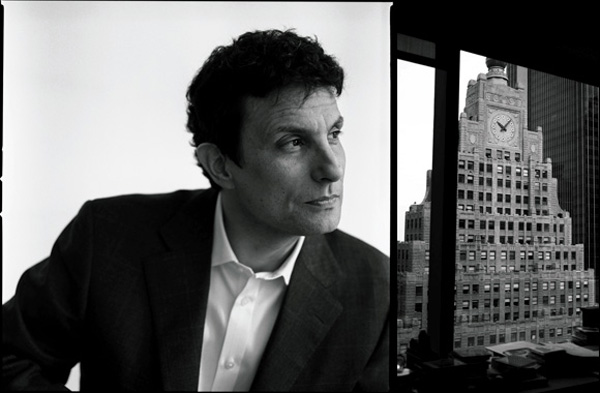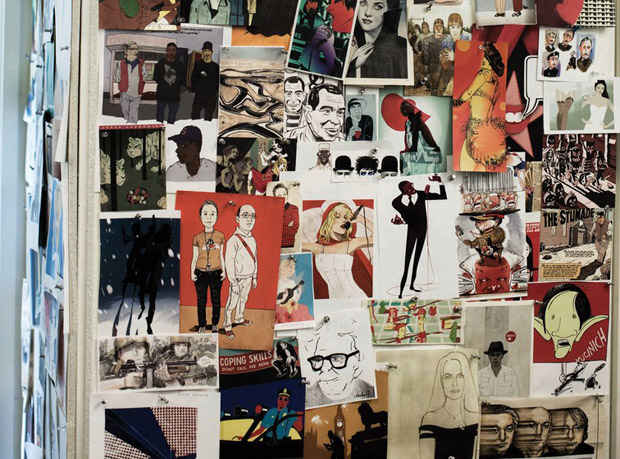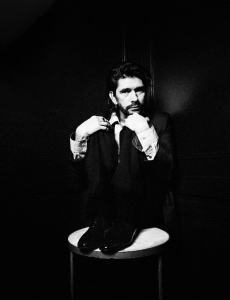-
.
David Remnick is arguably the most powerful editor in the world, yet shies away from publicity. In a world exclusive, author Nicholson Baker takes lunch with the man who has returned The New Yorker to its glory days.
.
David Remnick is 52. He’s got all of his hair, which is black, and he’s got an office with quiet brown carpeting and a desk made of a slab of grainy black wood and a fat-rimmed yellow ceramic cup that holds his pens and his pair of scissors. He’s smart and quick to laugh, and if you sit in one of the square soft chairs in his office, he remembers things about your life that you barely remember.
He likes baseball and The Wire and AJ Liebling and spaghetti with squid ink sauce. You might feel jealous of him except that he works too hard and nobody else would want that kind of constant hellish weekly pressure. His wife, Esther Fein, is a writer, and he’s got three kids. He’s the fifth editor of The New Yorker, which may be the best magazine ever published.
“You have to understand, for me to be at this magazine is preposterous. I feel like a pretender.”

.
Above left: David Remnick
Above right: The view from Remnick’s office at The New Yorker
I’ve met Remnick a few times, briefly. Once was at a party where he was chatting about boxing to novelist Joyce Carol Oates. Another time was in 2001, at the National Magazine Awards.That year his magazine won four awards, including the award for general excellence. Remnick kept striding up to the podium as we applauded him, wearing an impeccable blue suit and David Mamet-style glasses, and each time he found some new way to be abashed and thankful, as he was handed yet another copper-coloured trophy designed by Alexander Calder, the mobile-maker. (It’s called an Ellie and it looks like several modernist boomerangs glued together.)

-
The awards are deserved, but they don’t convey how consistently good his magazine is. Remember, it’s a weekly. Every Monday it’s in the mail, or in the newsstand, or on a little flat screen, reassuring a million subscribers that things are still pretty much under control in the transatlantic world of letters.
.
.
There are always at least a few funny cartoons, and one absorbing piece about something or another, and perhaps a brilliantly dismissive movie review by Anthony Lane, who sharpened his pencil at The Independent before Tina Brown, Remnick’s predecessor, lured him away.
.
“The awards are deserved, but they don’t convey how consistently good his magazine is.”

I confess I don’t read it all – few can – but let me just say it right now: The New Yorker is one of the three great contributions the United States has made to world civilization. The other two are, of course, Some Like it Hot and the iPhone. Maybe you have your own list. But it’s likely The New Yorker will be on it somewhere, because the magazine has been sharp and witty since the nineteen-twenties, angling unexpected adjectives in place with winning exactitude.
Above: The boomerang-shaped awards keep coming back.Right: Friday afternoon, Remnick looks over finished copy.
Its tone, from the outset, was, as John Updike described it in an onstage interview with Remnick, “big-town folksy”. EB White was one of the early sources of the style – along with James Thurber and Joseph Mitchell, and an alcoholic named John McNulty, who wrote stories about regulars at a bar on Third Avenue.Later there was Maeve Brennan, from Ireland, who wrote beautiful unfurling paragraphs about living in cheap hotels in the city, using as her byline The Long-Winded Lady. Brennan was evidently a little crazy toward the end, as writers tend to be, but in her Talk of the Town prose she is extremely sane and full of kind attentiveness.


-
And there were the cartoonists – Peter Arno, who liked drawing high-breasted showgirls, and Saul Steinberg, who made surreal black and white rainbows, and William Steig, whose trembly pencil seemed never to want to leave the paper, and George Booth, master of quizzically frowning brindle-eyed dogs. There were storytellers, too – JD Salinger, John Cheever, Updike, William Trevor, Alice Munro, and John O’Hara, who in his prime could tell a tight, bitter tale of private woe in 1,800 words.
.
A magazine that has been around for this long pulls its own history behind it like a battered Brio train. At the front is David Remnick, gently drawing it forward, helping it over the next little blond wooden hill, hoping that the shiny domelike magnets don’t detach.I was in The New Yorker offices, on the 20th glass-sheathed floor of the Conde Nast building in Times Square, one Friday in April.

 Above right: Previous covers line the corridor to the editor’s office.Above: David Remnick at his desk.
Above right: Previous covers line the corridor to the editor’s office.Above: David Remnick at his desk.
“He circles the floor several times a day and talks to people.”
The week’s issue had just closed, and the place was quiet. People stared at their screens, catching up with all the things they’d had put off during the recent editorial flurry. Remnick was having his picture taken, so I said hello to Pam McCarthy, the magazine’s deputy editor, whose office is next to Remnick’s. What is he like to work with? I asked her.
“He’s easygoing, and he’s not,” said McCarthy. “He likes to keep his finger on every detail. He really pushes until it’s right. He’s a great floorwalker. He circles the floor several times a day and talks to people.”

-

Above Friday afternoon, Remnick looks over the finished copy.
Just then Remnick came in with Alexa Cassanos, the director of publicity, and the four of us talked about earphones and earplugs. “In Maine why would you need earplugs?” Remnick asked me. (I live in Maine.) ‘When I’m out of the city,” he continued, “I’m up till four in the morning because it’s so damned quiet. I think somebody’s going to jump in and strangle me. It’s not relaxing.”“I’m up till four in the morning because it’s so damn quiet.”
We walked a few blocks to a seafood restaurant, Esca, on 43rd Street, where Remnick goes once in a while. Mark Singer, one of the magazine’s best-known writers of profiles, wrote a piece on Esca’s owner, Dave Pasternack, who does his own fishing around Long Island and knows how to cut mahi-mahi into raw tidbits.
Pasternack himself came by the table soon after we’d sat down and told us that he’d opened up a new business – a seafood concession in centre field of the Mets baseball stadium, where he sells crabcakes, fish sandwiches, lobster rolls, and chowders.Jeff Wilpon, the general manager of the Mets, lost a alot of money several years ago to Bernie Madoff’s Ponzi scheme, but, according to Pasternack, Wilpon was upbeat about his life.
“I was at a party the other day,” Pasternack said “and I go, ‘How’re you doing?’ Wilpon goes, “I was rich and miserable and now I’m poor and happy.'”
“Are you sure about the latter?” asked Remnick.
Suddenly I had a strange and not unpleasant sensation. I’d entered the printed pages of The New Yorker; I was physically inhabiting a Mark Singer profile, as edited by David Remnick.

-
Pasternack said, of Wilpon, “This is a guy who came to me to ask if I wanted to do a concession. I said ‘I’ll make a couple of things for you.’ I bring a lobster roll down – beautiful lobster roll, toasted bun, nice and buttery the way it’s supposed to be. He looks at me and he says ‘I don’t like toast.’
All I could think about is: when you’re born they give you toast, and on your deathbed they give you toast. Who in this world doesn’t like toast? When you’re sick they give you toast!””I get cartoons about toast every week,” said Remnick.
“Yeah?” said Pasternack.
“I got a cartoon,” said Remnick, “it was a toaster the size of the restaurant.” He turned to me. “Do you waste your time watching baseball?”
I said no, not really, I’m out of it.
Remnick said “I’m sure that when I’m on my deathbed…”“You’re going to have toast,” said Pasternack, with finality. Then he went away to fillet more fish.


-
I asked Remnick what his dining room was like when he was a kid. “Lots of mirrors,” he said. “We didn’t eat in the dining room.”
He grew up in Hillsdale, New Jersey – “Springsteen Jersey, without the shore” – and his mother got multiple sclerosis when he was six. Some years later, his father, a dentist, became ill with Parkinson’s disease. “To be a Parkinsonian dentist is like a Buster Keaton movie,” Remnick told me. “It’s funny unless you’re living it.” In high school he edited the school paper, The Smoke Signal, writing articles for it under several pseudonyms.
He wasn’t a devoted The New Yorker reader then. “Guitar Player” magazine meant more to me in high school than The New Yorker, he said. “There were no chord diagrams in The New Yorker.”He studied comparative literature at Princeton and took a class with The New Yorker writer John McPhee, who taught him that you have to be willing to seem stupid when you interview people. He spent a semester in Japan, teaching English and feeling lonely.
To be a Parkinsonian dentist is like a Buster Keaton movie. It’s funny unless you’re living it
He also went to Paris, where he wore a Leon Russell T-shirt and nine-dollar Converse sneakers and made money singing Bob Dylan songs in the Metro. His Princeton classmates were all getting jobs as investment bankers; he got a job at The Washington Post, as the night crime reporter. He covered boxing for a while, and then, as he limbered up, he interviewed celebrities in their hotel rooms. He was good, something of a prodigy in fact – a natural reporter, nimble and prompt with copy.
The Washington Post sent him to Russia in 1988, with his new wife, where he covered, with astonishing fecundity, every phase of the disintegration of the Soviet empire. He wrote somewhere between 300 and 400 stories a year, watching and learning from Bill Keller, the fast-fingered Russian correspondent for The New York Times, now its editor-in-chief.
Framed in Remnick’s office is the front page of The Washington Post for 24th August 1991, which has two Remnick stories. The top one begins: “Communist rule collapsed tonight in the Soviet Union after seven decades as President Michael Gorbachev resigned as Communist Party general secretary and ordered the government to seize all party property”.

-
.
He finds out that Kaganovich, by a strange coincidence, lives downstairs from him, and he knocks on the door. He knocks for a long time. There’s no answer. Every day he knocks. He finds Kaganovich’s number and calls it. No answer. He lets it ring for dozens of rings. Finally he reaches Kaganovich’s wife, who says her husband isn’t going to talk. He keeps calling; he wants to see, he says “what an evil man looked like”. He learns there’s a secret telephone code: let it ring twice then hang up and call again. Kaganovich answers. Remnick identifies himself. Kaganovich says, “No interviews! That’s it!” He dies soon after. But Remnick had at least heard the voice of the last of Stalin’s inner circle. There are dozens of scenes of poignancy and loss and upheaval in Lenin’s Tomb; it won a Pulitzer prize in 1994.
 .
.
“A lot of what I do is just the mental illness of persistence”
The bookshelves in Remnick’s officeBy then Remnick was freelancing for Esquire and Vanity Fair, and then staff-writing for Tina Brown’s The New Yorker, writing one telling profile after another – on Don DeLillo, on Mike Tyson, on Benjamin Netanyahu. On Netanyahu’s father, Remnick wrote, “has little white tufts of hair and weary, narrow eye, the eyes of a Chinese Scholar”. On Tyson’s fight with Evander Holyfield: “Incredibly, Tyson once more nuzzled his way into Holyfield’s sweaty neck, almost tenderly, purposefully, as if he were snuffling for truffles. He found the left ear and bit.” Remnick is modest about these writing successes, which he attricutes chiefly to “sitzfleisch” – the capacity to sit in a chair until the work is done. “A lot of what I do is just the mental illness of persistence,” he told me.

-
In 1998, Remnick published his second book, King of the Worlds, about one of the heroes of his youth, Muhammad Ali. Then something momentous happened: Tina Brown suddenly left her job in order to found a new magazine, Talk. (“Tina is more of a comet than a planet,” said Remnick. “She shines brilliantly and moves from thing to thing.”) SI Newhouse, The New Yorker’s owner, asked David to take over.
When the staff heard the news they stood and applauded for five minutes. “It was an applause of relief,” according to Remnick. “It was like the inner applause when you go to the neurologist and you find out that you don’t have a brain tumour.” The job wasn’t easy at first – he lost ten pounds in the first couple of months. It still isn’t easy. “You have to understand,” he said, “for me to be at this magazine is preposterous. I feel like a pretender.”
Actually, though, he’s the real thing: a great, omnivorous editor. He takes The New Yorker’s history seriously – he’s edited a series of anthologies of themed The New Yorker pieces from earlier eras – but he is just as determined that, in the era of blogs and iPads, he won’t be the last of the magazine’s master of ceremonies.
One of his biggest hits came in 2004: Seymour Hersh’s reporting on abuse in Abu Ghraib. He also brought Ian Frazier, a comic genius, back into the fold – Frazier had been on strike, more or less, during Tina’s tumultuous tenure – and he found and encouraged some good new writers, among them Ben McGrath, who can write deftly about anything, including football concussions and theorists of dystopian collapse.
After 9/11 Remnick had an odd (to me) burst of militancy, as so many did, writing with approval on the attack on Afghanistan, and, in famous comment piece in ‘Talk of the Town’, endorsing the invasion of Iraq. “I was wrong,” he told me, about Iraq. He wants his magazine to get truths out.
 A layout on his desk featuring President Obama.
A layout on his desk featuring President Obama.I asked him what he would have done if Julian Assange had offered him a basketful of Wikileaks documents. Of couse he would publish them, he said – he’d let the courts sort it out later. “I think the world is better off knowing than not knowing.”

-
Last year he published an enormous book about the civil rights movement and the rise of Barack Obama. He wrote it early in the morning, before leaving for work, and late at night. “Sitting next to him, if I hadn’t known he was writing a book, I wouldn’t have been able to tell,” Pam McCarthy told me. “I don’t mean to sound hagiographic, but actually he really is quite amazing. And exhausting.”
Remnick left me in his office while he did an afternoon circle of the 20th floor. I took some pictures of his bookshelves – hundreds of works by The New Yorker contributors past and present, books in Russian, a well-thumbed copy of the poems of WaltWhitman, and a recent run of the magazine bound in black and gold. Then I looked out of the window at a sign that said Toshiba in big letters, and another sign for Thomson Reuters. Down the street was the tarnished green roofline of the old The New York Times building, one of the seemingly few structures in the neighbourhood that was there when the magazine began. I looked at a snapshot of Remnick’s wife and children, at a small plastic windup radio, at a framed photograph of Updike, at another of Ornette Coleman, at hundreds of CDs, and at a nesting doll of Vladimir Putin, whose profile he wrote in 2003. On his desk was “the long” – the single big piece of paper with all the stories on it thatwere in the hopper, ready to go into future The New Yorkers. I felt like a trespasser, like a spy, too high up in the Manhattan skyline for my own good. I heard the discreet bong of a ringing phone. Remnick walked me to the elevators. “Remember what Barbara Walters said at the end of the Jimmy Carter interview?” he asked.
“No,” I said.
“Be kind to us, Mr President.”

Subscribe to Port Magazine annually and receive each issue to your door.
Get PORT in print



